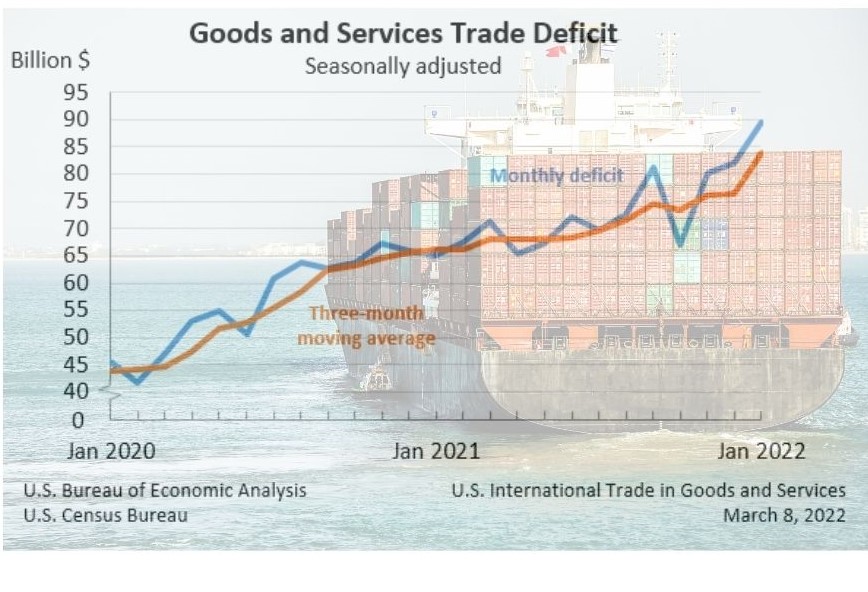The year is starting off with the U.S. breaking another trade deficit record, this time hitting $89.7 billion, up 9.4% from December, the Bureau of Economic Analysis said on Tuesday.
January exports of both goods and services totaled $224.4 billion, $3.9 billion less than December exports. And January imports were $314.1 billion, $3.8 billion more than December imports. The January increase in the goods and services deficit was due to an increase in the goods deficit of $7.1 billion to $108.9 billion, a record-breaker.
“In January, the U.S. chalked up the largest monthly trade deficit, $89.7 billion, in U.S. and world history,” said CPA chief economist Jeff Ferry. “This huge deficit, on top of the pandemic disruption to essential supplies, the semiconductor shortages crippling our auto industry, and the impending shortages due to Russia’s war should be reminders of the urgent need to rebuild domestic capacity and reshore major industries.”
If the U.S. continues with a $100 billion+ monthly deficits, it will smash the 2021 goods deficit record of $1.09 trillion this year. It is unclear if this will continue given war in Ukraine and higher fuel and commodity costs that may lead to business and consumers spending much less in the months ahead.
Year-over-year, the goods and services deficit increased $24.6 billion, or 37.7%, from January 2021. Exports increased $29.9 billion or 15.4% while imports increased $54.4 billion or by 21% as the economy hums back to life thanks to record stimulus and local businesses getting back to pre-pandemic activity levels.
January’s Biggest Deficits
China is making a comeback. It’s back to being the U.S.’s biggest deficit by far ($33.3 billion), followed by the European Union ($18 billion), Mexico ($12.5 billion), Japan ($7.1 billion), Canada ($6.8 billion), Germany ($5.4 billion), and Taiwan ($3.9 billion.
- The deficit with Canada increased $2.6 billion to $6.8 billion in January due to commodity imports. Exports decreased $1.2 billion to $27.7 billion and imports increased $1.4 billion to $34.5 billion.
- The deficit with Japan increased $2.1 billion to $7.1 billion in January. Exports increased $0.1 billion to $6.2 billion and imports increased $2.2 billion to $13.4 billion.
- The deficit with Vietnam increased by $2.3 billion to $9.1 billion in January, another record. Vietnam ranks third-largest deficit country for the U.S., behind only China and Mexico.
With Russia and Ukraine in the news, our trade deficit with Russia remained steady at $1.5 billion for January while our deficit with Ukraine was $21.9 million. Most of this is the commodities trade, led by petroleum and pig iron imports. All told, the U.S. spent $13.6 billion on crude oil imports from around the world, up from $7.4 billion in January 2021. The U.S. spent $1.6 billion importing natural gas, including from Russia, compared to $339 million in January 2021.
What the U.S. Imported in January
Imports of goods on a Census basis increased $4.6 billion. The types of items the U.S. spends most of its money on remain the same month over month, dominated by automotive, pharmaceuticals, and electronics as always.
Crude oil and natural gas imports rose, with the U.S. spending a combined $1.5 billion on imported fuel. Copper imports also rose.
According to the BEA, food and beverage imports rose to $2.1 billion with meat imports accounting for 10% of the total. U.S. cattle ranchers have been complaining that their beef is being substituted with foreign imports.
| Top Five Imports | January | December | Vs January 2021 |
| Pharmaceuticals | $15.7 billion | $14.8 billion | -$1.45 billion |
| Passenger cars | $13.5 billion | $12.7 billion | -$573 million |
| Cellphones | $13.1 billion | $13.2 billion | +$3.1 billion |
| Car parts | $10.5 billion | $10 billion | +$506 million |
| Computers | $9.2 billion | $9 billion | -$7 million |













